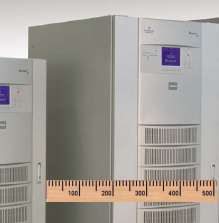UPS Sizing - Rules of Thumb
 Not so long ago I was telling someone that I don't use rules of thumb as most things are easily calculated anyhow. As it turns out last week I ended up sizing some UPS using what can only be described as rules of thumb. In deference to my change of heart here are my UPS sizing rules of thumb.
Not so long ago I was telling someone that I don't use rules of thumb as most things are easily calculated anyhow. As it turns out last week I ended up sizing some UPS using what can only be described as rules of thumb. In deference to my change of heart here are my UPS sizing rules of thumb.
First rule; kW and kVA are related by 0.8. This does not apply to all UPS, but it does for many (and is the worse case). People often get confused with what this means, so I'll try to explain it a little. Each UPS has a maximum kW and kVA it can deliver (related by 0.8), for example a 100 kVA UPS can deliver a maximum of 100 kVA or maximum of 80 kW. Some examples will make this more clear (assuming a 100 kVA, 80 kW UPS):
- load is 80 kW at 0.7 power factor = 114 kVA - exceeds maximum kVA
- load is 80 kW at o.8 power factor = 100 kVA - UPS is good
- load is 80 kW at 0.9 power factor = 88 kVA - UPS is good
- load is 100 kVA at 0.7 power factor = 70 kW - UPS is good
- load is 100 kVA at 0.8 power factor = 80 kW - UPS is good
- load is 100 kVA at 0.9 power factor = 90 kW - exceeds maximum kW
Some people work in kVA, but I always choose to work in kW. kW is the measure of power used by the equipment and it make sense to me to use that. It can also be added arithmetically to give a technically correct answer (kVA cannot as it is a vector quantity). Once I have the final load kW, divide by 0.8 to get the kVA and select the next largest standard UPS size.
I used to size UPS systems to run at full capacity. Many individuals and institutions like to limit the loading on a UPS to 90% of it's rated full load current. After much arguing I have decided to hold my hand up, surrender and follow the same rule. Given a load requirement in kW, I divide by 0.9 (90% rule) to get the kW to size the UPS.
The charging of batteries (if discharged) and losses/efficiency of the UPS itself mean that input power to the UPS is larger than the output. UPS units are invariably rated on output power and this needs to be adjusted to determine the loading on the supply system. Typically allowing 20% for battery charging and UPS losses is a good approach - more than required, but not excessively so.
Finally in larger installations the above is combined with the black art of selecting the correct size and number units. Space, cost, redundancy, etc. all affect the final selection. Is a single 300 kVA UPS better or worse than two 150 kVA units. How do two 300 kVA units in N+1 redundancy compare with three 150 kVA units in N+1 redundancy. When selecting the UPS for larger installation it can be difficult. Unfortunately I don't have any rules for this. I try to look at the system as a whole (power to the UPS, how the UPS power is to be distributed, redundancy requirements, etc.) and put a few configurations on paper. As these are developed into a workable concept one of the options tends to become the obvious one to choose.
Example
Finally here is an example of how the selection may go:
- requirements - 166 kW of UPS load, N+1 redundancy required
- selection - 90% rule requires 184 kW which at 0.8 = 230 kVA
Some options would include 2x250 kVA or 3x120 kVA or 4x80 kVA (each giving N+1 redundancy). The later options require more units but results in less installed UPS kVA (cost would likely be comparable). I generally prefer smaller units as they are easier to handle/move around, and in this instance I would be tempted to select the 3x120 kVA option. I think the 4x80 kVA option would be pushing the boundary; while it still maintains N+1, the chance of one of four failing is greater than one of three (taken to extreme 23x10 kVA units is obviously not feasible).
Summary
As the example shows, the rules of thumb (90% and 20%) give a required kW on which to base UPS selection and input power to the UPS. kW and kVA are related by 0.8. In larger installations there is no right or wrong selection of the size and number of UPS units. Different engineers will likely arrive at different, but still workable solutions. This mixture of experience and engineering art is not dependant on decimal accurate figures and values obtained by using simple rules of thumb are generally sufficient.
Related Links